COVER STORY
Cornell in 2065: 'What I see happening'
We asked professors, administrative leaders and students: What will your area of expertise be like in the year 2065, when the university celebrates its bicentennial?
Pulitzer Prize-winning historian and Vice Provost for International Affairs Fredrik Logevall pointed out, modestly, that historians are not that good at predicting the future. And professor Joe Fetcho reminded us that science, by its very nature, is unpredictable.
But these are Cornellians working at the cutting edge, doing work that is defined by questions like "What if?" and "Is there a better way?" and "What does it mean and why?" They are in the habit of thinking beyond constraints, limitations and the status quo. In short, these are the perfect people to ask about the future of cancer treatment, architecture, music and flying saucers.
– Emily Sanders Hopkins
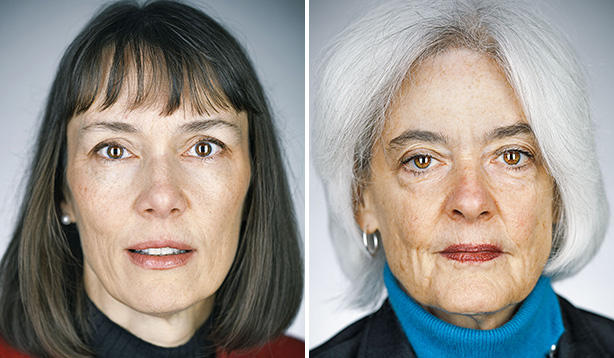
From left to right: Marjolein van der Meulen and Susanne M. Bruyere
One-size-fits-one medicine
Marjolein van der Meulen is the James M. and Marsha McCormick Chair of Biomedical Engineering, the Swanson Professor of Biomedical Engineering and a professor in the Sibley School of Mechanical and Aerospace Engineering.
Before biomedical engineering became a fully recognized specialty in engineering with the founding of the Biomedical Engineering Society in 1968, Cornell engineers were already at the leading edge of work at the intersection of engineering, medicine and biology. For example, Cornell engineer Wilson Greatbatch created the world's first practical implantable cardiac pacemaker in 1958.
As Cornell celebrates its 150th year and the field of biomedical engineering nears its 50th anniversary, one trend I see is the move away from medical devices and toward cellular, organic and biological solutions to health problems. The field of tissue engineering will continue to grow, and these biological solutions may look very different than they do right now, but they are coming.
This move toward cellular treatments is linked closely to another trend that will continue in the next 50 years: personalized medicine. Biomedical engineers will take advantage of the growing ability to query an individual's RNA and DNA at the single-cell level. We will learn how to interpret and synthesize massive amounts of information to design medicines and treatments specifically for particular patients.
The next five decades also will see ever-increasing collaborations between biomedical engineers and researchers in other fields. The White House's BRAIN Initiative is an excellent example of the sort of collaborative efforts that are possible. The ultimate goal of biomedical engineering is to translate our knowledge and understanding into clinical applications. To do this requires collaboration across disciplines – and collaboration is in Cornell's genes.
Working from work
Susanne M. Bruyère, the ILR School's associate dean of outreach and a professor of disability studies, says, "The challenge will continue to be: How can we educate more effective leaders and managers of people in the workplace? And how can we protect the rights of the individual worker?"
There will be adjustments to be made, Bruyère anticipates. "And tensions between a more virtual workplace – with flexible hours because people have more complex lives – and the recognition that people need the affiliation of working together, eyeball to eyeball, in teams. With employers having more dispersed teams of people, we could see a pulling back" from the virtual workplace, she predicts.
Beyond a fundamental awareness of diversity, Bruyère says, "We have to change the dialogue, to talk about being inclusive. Inclusion means people are individually valued for the contribution that they make to the organization."
A school such as ILR, with approximately 40 percent international undergraduate and graduate students – and many American-born students provided with opportunities for studying abroad – is an ideal place to learn about the increasingly global workplace, Bruyère believes. "Our students are asking for internships abroad, in private sector workplaces and unions, social enterprises and nonprofits in many, many different countries. We want them to bring back those experiences to enrich the conversation in the classroom."
"We are preparing professionals, whether they are coming from other countries or [are] young Americans, for these kinds of globalized contributions," Bruyère concludes. "We really have a responsibility to prepare a global workforce, and we have that opportunity."
Vice Provost for International Affairs Fred Logevall agrees. "My No. 1 priority in the coming months," he said in January, "is to internationalize the curriculum. We have an obligation to educate global citizens."
– Roger Segelken
A post-private world is coming
A professor at the Jacobs Technion-Cornell Institute at Cornell Tech, Ari Juels includes "applied cryptography, privacy and security" in his shortlist of expertise. But he predicts that in a half century, all but the last item as we know them today may well become obsolete – the first threatened by code-breaking quantum computers and the second by emerging technologies and a growing culture of information-sharing.
"Quantum computing would render easy those problems whose hardness the field of cryptography relies upon," Juels explains. He points to cryptographic protocols in browsers – which encrypt information such as credit card or Social Security numbers – as being especially vulnerable to attacks.
On the topic of privacy, he explains that it's a "historically transient" phenomenon: "It used to be that, more or less, people lived in relatively small communities in which everyone knew everyone else's business." He adds that big data and social media are speeding what he describes as the inevitable "erosion" of privacy.
"It's become increasingly easy for others to gather information about us," he says. "And we're showing an increasing willingness to have information gathered and published and disseminated in various ways."
Data security might be the only battle left to fight: If we can't control what others know about us, we might at least be able to control what they do with that knowledge.
"We'll have to think about the policies to apply in this data-rich world, and we have to hope that the discipline of data security will provide us with tools to enforce these policies rigorously and meaningfully…" he says. "We can ensure, for instance, that insurance premiums are not based on our genetic data."
In a post-private world, safeguarding the accuracy of each other's information will also be vital. That, at least, might be an easy task: "Given perfect transparency, it's hard to lie," Juels says.
– Jose Beduya

From left to right: Estomih Mtui and Lorin Warnick
High-speed doctors
In the Human Structure and Function class at Weill Cornell Medical College, first-year medical students, who once spent valuable time hunting down anatomical information in libraries and anatomy atlases, now have the Weill Cornell Dissection Manual iPad app at their fingertips.
Without fumbling through books, notes or cards, the students work with cadavers and boost their essential anatomy knowledge more with an iPad, according to Dr. Estomih Mtui, professor of anatomy and director of the Gross Anatomy and Body Visualization Program at Weill Cornell. Mtui led a digital initiative that integrated iPad technology with the anatomy curriculum.
"It's made life easier for the medical students, giving them the ability to absorb more information, giving them a better foundation, as they are better trained and better prepared to face the challenges of the future," he says.
After the iPad tablets were incorporated into the curriculum, grades improved eight points, on average, for the first exam in the anatomy class, according to Mtui.
Mtui advocates exporting quality health care around the world and spends each summer teaching anatomy at the Weill Bugando University College of Health Sciences in Mwanza, Tanzania, and Kilimanjaro Christian Medical Centre in Moshi, Tanzania.
With tablet apps on anatomy and other medical topics, students in the United States and abroad can become excellent doctors faster, Mtui says.
In about 25 years, Mtui estimates, the medical education knowledge gap will close between Western and developing countries, learning for health care personnel will become bi-directional, and disease outbreaks like the "catastrophic situation" presented by the recent Ebola virus crisis in western Africa will be reduced.
"It's going to take time, for sure, to significantly close the gap between health care learning in the United States and places like Tanzania," says Mtui. "This technology revolution is moving fast. But it is not fast enough."
– Blaine Friedlander
Bedrock of vet medicine will remain the same
Lorin Warnick is associate dean and director of the Cornell University Hospital for Animals at the College of Veterinary Medicine.
Veterinary education has come a long way since James Law arrived at Cornell in the 1860s. His state-of-the-art teaching tool was a papier-mâché horse with removable organs. What would Law make of PowerPoint animation?
The veterinary profession also has changed. Today's veterinarians provide clinical care for pets and performance animals, help ensure a safe and plentiful food supply, conduct biomedical research, promote wildlife conservation and work to prevent the transmission of disease from animals to humans. They have equipment and medications that Law could only dream about.
In 50 years, some of today's new faculty will be retiring after teaching generations of students. Veterinarians routinely will use gene-based testing, treatments being developed today and will find innovative solutions to current problems such as drug-resistant pathogens. Scientific and technological advancements will yield improved methods for preventing, diagnosing and treating disease.
However, the bedrock of veterinary education and medicine will remain the same: In-person, hands-on work with animals to protect and promote their health and well-being.
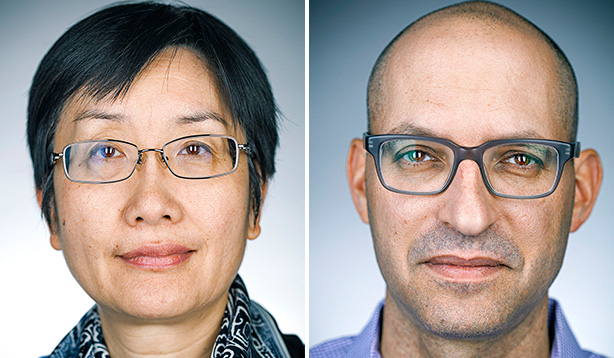
From left to right: Xin Li and Mor Naaman
Meditation libraries
Anne R. Kenney is the Carl A. Kroch University Librarian at Cornell University Library; Xin Li is the associate university librarian for central library operations.
Fifty years from now, we will still need places where people come together, but the spaces may look very different. Cornell's library may still be headquartered in Ithaca, but it will be present in every single place, all around the world, wherever Cornellians are learning and working and solving problems.
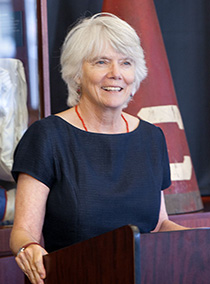
Anne Kenney See larger image
Data about us will be collected around the clock and will affect most of our lives. Education will be completely different; the current model, where all 7-year-olds sit together and learn the same thing at the same pace, will disappear and be replaced by individually tailored experiences for each student.
Libraries could step into the virtual void in that environment – not to provide solutions but to help students be inspired globally, but act deeply personally, in developing their own sense of authority. And libraries have a sacred trust to tailor experiences in a protected space.
We believe wealth and power will be even more unevenly distributed, and that these social inequalities will drive international policy. So our library needs to be an honest broker of information, serving not just Cornellians but those who are disenfranchised.
The library can provide the sense of a cultural and residential experience, the opposite of dispassionate distance. For example, how great would it be for the library to re-create a medieval city, drawing on textual evidence, visual resources, the laws of physics and engineering? You could immerse yourself in what life would have been like.
There will be a huge desire to go retro, because at some point you'll want to know what things are or were like physically; otherwise we'd all feel more and more like robots. Libraries can fill that void. We believe they will remain places for reflection and deep concentration. There will be precious few places for that kind of reflection – neutral places that have no agenda, that aren't mining you for data. There's a kind of brain-robbing that goes with collecting and linking data for profit; libraries need to resist that, and we think we will.
Staying connected with big data
The platforms through which we communicate, store and share information, and create and consume media are becoming inseparable, according to Mor Naaman, an entrepreneur who co-founded Seen.co and is an associate professor at Cornell Tech, where he directs the Connective Media program for the Jacobs Technion-Cornell Institute.
Naaman foresees a future where big data will continue to balloon and new technologies will enable individuals and communities to access and integrate this overabundance of information in day-to-day affairs.
Imagine, for example, a scenario where it's the norm for people to be sharing their physical location and other personal information at all times, perhaps because technology exists that allows them to do it in a privacy- and battery-preserving manner. "Among other things, we will be able to model and predict traffic much better than we can now," says Naaman. In cities like New York, where density will be an even more urgent issue, he predicts data science and connective media will help control the spread of illnesses and help optimize services, from public health to park maintenance.
Naaman points out that technological advances will need to be regulated and tempered by policies, safeguards and a deeper understanding of "the human and social aspects of technology."
Glimpsing an era where everyone is even more widely connected to anyone and anything, he poses a question that is at the heart of his research and teaching: "How can we use these new technologies to improve our ties to the people that matter to us – not to everyone out there – but to our friends, our family, our neighbors?"
– Jose Beduya
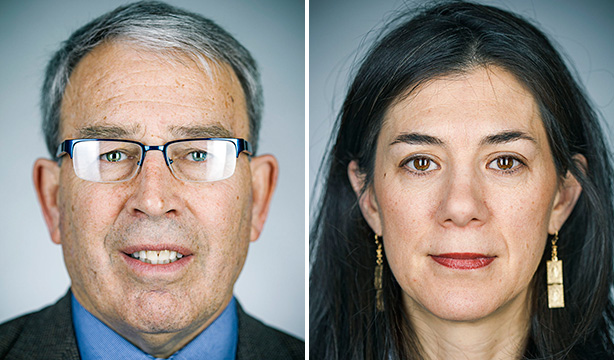
From left to right: Andy Noel and Wendy Wolford
Fantasy recruitment
Andy Noel is Cornell's Meakem♦Smith Director of Athletics and Physical Education.
For all of humankind, competition has been one of the greatest forms of communication. In half a century, as people continue to tether themselves to their digital footprint, athletics will separate itself as one of the key areas in which humanity will be united in a meaningful way.
The NCAA's shift toward autonomy for its major conference schools allows them to play by rules that often deviate from the traditional model of collegiate amateurism. Cornell, and its partnership with the Ivy League, will assure that our student-athletes will still compete at the highest levels without sacrificing the ideals of sport within the context of collegiate education.
Over the next many decades, there are plans for central campus to expand Cornell's Ithaca footprint. The future may include the creation of a "varsity village" that will accommodate a desire to populate central campus with additional state-of-the-art academic facilities. Innovations in equipment and sports medicine will continue to make athletics safer for its participants. Technological advances, like virtual reality, will likely bring prospective student-athletes to campus. Seated in their own living rooms, prospects and their parents will be able to feel the chill of the ice while their classmates chant in Lynah Rink, experience the football team marching to Schoellkopf on game day (led by the Cornell Marching Band) and experience a last-second, three-point shot for a win as part of Newman Nation.
What can be assured is that whatever collegiate athletics has become when the university celebrates its bicentennial, Cornell will be at the forefront of empowering student-athletes in the classroom and in the arena.
Too close to call
Wendy Wolford is the Robert A. and Ruth E. Polson Professor of Development Sociology and is faculty director for economic development programs at Cornell's Atkinson Center for a Sustainable Future.
Charles Dickens said it best: It is the best of times, it is the worst of times. Perhaps never before has the field of economic development seemed to hold so much potential for growing new economies, healthy citizens and responsive, democratic societies – the best of times – while being fraught with growing inequality, environmental degradation, human deprivation and social unrest – the worst of times.
Over the next 50 years, it will become clear whether the best we can do is enough to address the worst of what we have done. We have no real precedent for this: the field of economic development has always been the study of the past, where developed countries like England were held up as examples for developing countries to follow. But the next five decades will see new issues and actors, ones that seem to have no exact historical parallel, like the rise of China, climate change, transnational civil society, mass species extinction and widespread resource degradation.
China and the rest of the emerging economies (Brazil, Russia, India and South Africa) are reshaping the international agenda through what is optimistically called "South-South Development," where emerging countries partner with developing ones to transfer knowledge and experience. Climate change requires new strategies in rich and poor nations alike, ones that address both overconsumption and poverty. At the same time, transnational civil society, from international nongovernmental organizations to farmers' movements and Twitter followers, will play an increasingly visible role. The rapid loss of species in the Anthropocene (the first geological era dominated by human activity) will require this transnational coordination if whole ecosystems and populations are not to be lost.
Finally, the question of whether or not the next 50 years of development are sustainable is, not surprisingly, the most pressing issue for the future. The next 50 years will be pivotal in determining whether we see the best of times or the worst: Whether development can generate fertile land, clean water, living forests and renewable energy, or leads to increasing exclusion and war over limited resources. At the very least, there is still a choice.
Agricultural balancing act
"As a plant breeder, I feel the looming challenges for our discipline are huge," says Margaret Smith, professor of plant breeding and genetics.
Challenges include a growing world population that will require farmers to produce as much food in the next 50 years as has been produced in the entire history of settled agriculture, says Smith. She researches sweet and field corn breeding to develop new varieties for farms in New York state and internationally.
She also seeks to enhance understanding of corn adaptation to marginal environments.
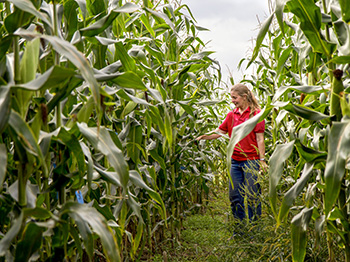
Margaret Smith. See larger image
When Smith looks into the crystal ball of her research area, she envisions a world that will require more nutritious food grown on limited arable land. That finite amount of land must also bear the burdens of soil degradation and increased meat production, as populations become more affluent, creating shifts in dietary patterns that include more animal protein.
"Demands [for food on limited land] will go up rapidly, and as if that's not enough, we have to lump climate change onto it," she says.
Shifts in climate patterns pose risks for unpredictable rainfall in the U.S. corn belt, where four states produce a quarter of the world's corn, Smith says. And countries across the developing world, including those in sub-Saharan Africa, will have greater stressors from projected high temperatures and drought.
"The discipline of plant breeding will need to be alert to being as efficient as we possibly can," Smith says.
She advocates using traditional breeding methods to create new populations of plants that tolerate modern stressors, and then use the tools of genetics to evaluate how adaptations occur.
– Krishna Ramanujan
Scare tactics will get less scary
Instead of "Ebola hits New York," the risk-savvy headline should have been "Texting while driving kills New Yorkers."
Katherine McComas, department chair of communication in the College of Agriculture and Life Sciences, is reality-savvy enough to know what kinds of information drive the media world – and what that landscape might look like in the future.
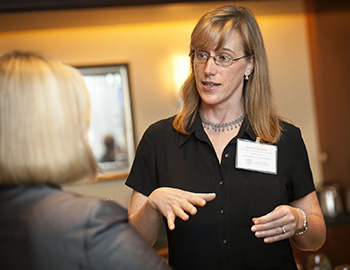
Katherine McComas See larger image
"The risk of catching Ebola as we go about our daily lives," McComas says, "is just about zero – yet people don't always pay attention to what the scientists think are the most dangerous things; they fixate on others that have much less likelihood of happening to them."
That's too bad for the general public in an increasingly perilous world, but McComas and her Cornell colleagues in the social sciences have moved beyond that perception glitch to explore the deficit of trust in what's becoming the Too Much Information Age.
"We have to move past a knowledge-only paradigm – this belief that if people just knew the risks then they would act the way we think they should – because people in their day-to-day lives have to make decisions on so many things; [it's] a field of messages from so many different sources. One of the things they're going to base a decision on is: 'Can I trust the person who's talking to me? Can I trust in the process?'"
She cites two areas of research where Cornell is thoroughly engaged and nonscientists frequently question the process: Climate change and genetically modified foods.
Here at Cornell, McComas says, "there is a genuine effort to try and understand these wicked problems" that will challenge humanity throughout the 21st century. "This is where the transformational research will happen."
– Roger Segelken
Power up local
In 50 years, people can expect that renewable energy sources will be better integrated with traditional power sources and energy systems will become less centralized, says C. Lindsay Anderson, assistant professor in the Department of Biological and Environmental Engineering.
Anderson, the Norman R. Scott Sesquicentennial Faculty Fellow, researches how to improve integration of renewable energy into existing power systems.

C. Lindsay Anderson See larger image
Currently, the U.S. has huge centralized power sources that distribute energy to residences and commercial interests and serve entire regions of the country. But Anderson predicts that the U.S. will move to smaller sources that are geographically distributed and serve smaller areas.
Much like how financial investors recommend portfolio diversification to buffer market fluctuations, smaller energy sources that are spaced out from each other "will make the system more robust," Anderson says.
These same principles of decentralization and distribution apply to low-carbon, renewable energy sources such as wind farms. For example, a large wind farm gets in trouble when winds die down, but if many, smaller wind farms are spread out over a larger area, there is more diversity and resilience built into the system, she explains.
"I don't think we can ever replace fossil fuels completely," Anderson says. "But I would hope to get to 50 percent" of energy needs met by solar, wind and geothermal, for example, in 50 years.
Solving our energy issues will require improvements in math, computational power and speed, environmental, electrical and mechanical engineering, and policy. "It's an interdisciplinary problem," she says.
– Krishna Ramanujan
Buildings as organisms
"The future of architecture, paradoxically, is in its past," says assistant professor of architecture Aleksandr Mergold. "Not in the nostalgic reference to the older built forms, but in the radical change in design thinking, driven by necessity in favor of adaptive reuse, re- and up-cycling, creative and radical reappropriation of old materials, technologies and ideas in the face of adverse climate and scant resources.
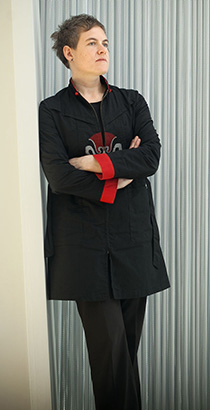
Jenny Sabin See larger image
"The future of architecture is in the pursuit of resiliency, and it will require all the tools available to us. The future is in the understanding that we are a part of a continuum much grander than we can observe on our personal horizons of history and the future," Mergold says.
"Buildings in the U.S. account for nearly 40 percent of total national energy consumption," assistant professor of architecture Jenny Sabin says. "Most contemporary sustainable approaches to the problem offer technological solutions through sanctioned rating systems. These measures adequately address issues of resource consumption in buildings, [but] do not address the systemic ecology of the built environment over the long term. How might we rethink our conceptual approach toward the problem?
"A developing field in architecture – matter design computation – places emphasis upon adaptive architecture and programmable matter. In 50 years, buildings will behave like organisms in their built environments. … Like the cells in our bodies, sensors and imagers will learn and adapt, making materials not only smart, but also aware, sensate and beautiful. We will be able to tune our spaces, to personalize architecture.
"Architecture as we know it will change, but the role of the architect will become ever pressing."
– Daniel Aloi
Goodbye, tray. Hello, conscious eating
Campus dining of the past included trays, mystery meat and few options from your residence hall's kitchen. Campus dining of the future might look more like restaurants serving super healthy choices made from ingredients grown on campus.
And there might not be a tray in sight.
"People will bring their own flatware to cafes the way many people now bring mugs for coffee," says Jane Mt. Pleasant, associate professor of horticulture and a member of the food focus group of the President's Sustainable Campus Committee.
"Everyone on campus will have an understanding of what it means to be an environmentally conscious eater," she says.
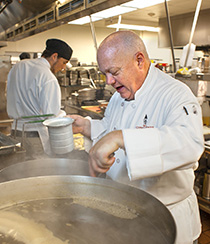
Steven Miller See larger image
Tray-free dining, already in effect at Robert Purcell and North Star, Cornell's two biggest all-you-care-to-eat facilities, saves on resources to clean trays and prevents wasted food – two key steps toward making dining at a large university sustainable.
Increased sustainability – using limited resources to feed a large campus efficiently and effectively – is the future of campus dining, says Steven Miller, executive chef of Cornell Dining.
"Cornell Dining is a beacon for many other dining services." Miller says, because it uses fresh ingredients from local sources, some of them on Cornell land. Miller would like to increase this partnership in the future. Cornell Dining pays market price for sweet corn, potatoes, squash, onions, peppers and other crops. In the summer, the only vegetable that does not come from local or campus ("hyper-local") sources is lettuce.
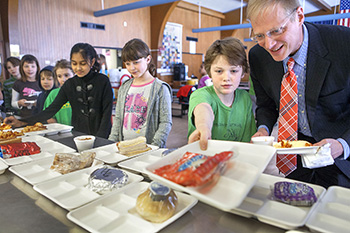
Brian Wansink See larger image
Cornell composts 1 million pounds of postconsumer food scraps every year, another major step toward sustainability.
Brian Wansink, the John Dyson Professor of Consumer Behavior, and his team at the Cornell Food and Brand Lab are working with engineers at Google to develop an app (currently in prototype) that will create a calorie count based on a photo of your meal.
Highly customizable food is the future of dining, Wansink says. The more a person is involved in creating her meal, the more she has a sense of ownership, and the more healthy choices she makes.
Future dining is healthy dining and healthy dining is within reach, says Wansink: "Make salad as enticing as BBQ pizza," he says, "and people will eat salad."
– Kate Klein
The brain-everything barrier
Joe Fetcho is a professor in and associate chair of the Department of Neurobiology and Behavior.
I was once asked early in my career, when interviewing for a faculty job, where my research program would be 10 years forward. My answer was that it was not predictable and, if it were, I would have a colossally boring career, with minimal scientific contributions. Scientific discovery by definition is not predictable, but discoveries are what determine the trajectory of scientists and of the field.
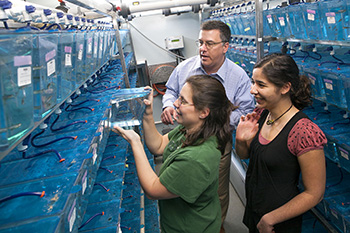
Joe Fetcho See larger image
I can't predict in any specific way where the field of neuroscience will be in 50 years. What I can say, with confidence, is that the discoveries that drive our understanding of the brain, one of the most fundamental and still most mysterious inventions of evolution, will come at the interfaces between disciplines including physics, chemistry, engineering, computational sciences, mathematics and humanities, along with the more conventional biologically oriented disciplines. I expect that the already-fuzzy boundaries between these areas will dissolve further. This is essential if we are to move toward building the tools that allow us to explore the brain, interpret massive streams of data collected from it, and place that evidence in the context of the behavior of humans and other animals. This is what it will take to reveal what makes us who we are and to understand ourselves well enough to fix the increasing number of broken brains.
Cornell's interdisciplinary tradition and excellence places us in a special position to contribute to the goal of understanding the mysterious lump of cells that governs how we think and feel. The trajectory toward that goal is unknowable, but I think it will require a dissolution of traditional academic boundaries and training that will change the character of universities in the coming decades.
Targeting cancer precisely
In 2014, doctors diagnosed an estimated 1,665,540 new cancer cases in the United States, with about 1,600 people dying each day, or 585,720 cancer deaths last year. Among all causes of death, cancer remains number two, and accounts for one death in every four.

Himisha Beltran. Image: Roger Tully. See larger image
Oncologist Dr. Himisha Beltran, assistant professor of medicine at Weill Cornell Medical College, believes that over the next few decades, those statistics will improve, thanks to a better understanding of cancer biology and genetics and its role in the disease.
With more information available, Beltran says that within a decade, there will be continued development of new targeted therapies, allowing doctors to treat cancer more effectively. Beltran works with a team of doctors and scientists at the new Institute for Precision Medicine at Weill Cornell to understand how genetic alterations across many cancer types influence patient response to cancer therapies.
"Beyond chemotherapy and radiation, we ask, 'Are there molecular therapies?' We are trying to match the best therapy and the right, precise medicine for the patient based on their cancer's underlying molecular alterations," Beltran says.
Beltran conducts research on an aggressive type of prostate cancer, neuroendocrine prostate cancer. In research led by Beltran and her colleagues, a molecular target for neuroendocrine prostate cancer was found and currently is being tested in clinical trials.
A half-century from now, she predicts there will be more nonchemotherapy strategies, more molecular-based approaches and less unnecessary treatment.
Looking toward that 50-year mark, Beltran said: "We'll see more patients surviving cancer, if not find that it's been cured."
– Blaine Friedlander
Not just older, but wiser
Corinna Loeckenhoff is an associate professor of human development and a gerontologist whose research focus is in health care choices.
A few decades down the road, patients may not only ponder the best treatments for life-limiting conditions, but also consider interventions to substantially extend their life spans. But even if 120 becomes the new 80 and someone discovers the ultimate wrinkle treatment, gerontology will not become obsolete.
Only recently, the field has moved beyond an emphasis on age-related mental and physical decline to consider the role of other factors such as accumulating life experience or the awareness of passing time. Such mechanisms are likely to drive age-related shifts in the way we think, feel and relate to others, no matter how long and healthy our lives one day become.
When I teach classes in gerontology, I jokingly tell my students that they should listen well, because by the time they're at the tops of their careers, I will be old. I can only hope that by then, the people in charge have a good understanding of aging.
Greek life: Changing faces
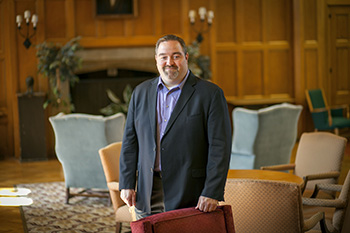
Travis Apgar See larger image
Student demographics and changing modes of learning will have an effect on the future of Greek life at Cornell and elsewhere, says Travis Apgar, the Robert G. Engel Associate Dean of Students.
"I have to imagine that, in many ways, fraternities and sororities will look similar [to today] – in the sense that I think that many of them will still have a housing component," Apgar says. "But if we look at the trends of what's happening in higher ed in general, you can imagine that there won't be as much need for housing in 50 years – there is a possibility that more people will utilize online instruction."
On campus, he says, "I think the experience may be very different, however, because of the type of student that will end up here, and at most colleges – literally, the face of our students will change over 50 years' time.
"The demographics will change drastically. We live in an age now where there are more women attending than men – 50 years ago, that wasn't the case. Fifty years from now, it's likely that we will have more people of Hispanic or Latin descent, and many other ethnicities and races. And their interests likely will be different.
"This means that the organizations will have to change in order to be relevant."
Greek organizations that in the beginning were devoted to "educational and academic achievement, literary societies, law societies – these organizations will go back to their core roots," Apgar says. "There will be a resurgence of focus on why they were founded."
Recent measures to eliminate pledging and hazing, and changes in policy at national organizations led by alumni, are spurring this return to founding ideals, Apgar says.
– Daniel Aloi
Environmentalists as happy as clams
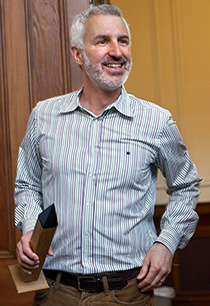
Todd Cowen See larger image
Todd Cowen is a professor of civil and environmental engineering and the faculty director for energy at Cornell's Atkinson Center for a Sustainable Future. He was also part of the Climate Action Plan Acceleration Working Group that recommended the Cornell campus become carbon neutral by 2035 – an acceleration of the 2050 goal President Skorton signed eight years ago.
"My hope is that by 2065, we will have generations of Cornell graduates for whom it is normal to be living on a carbon-neutral campus and in a carbon-neutral world, and [to have been] raised in a carbon-neutral household," Cowen says. "And that Cornell was instrumental in setting that path because we were one of the first major institutions to make that commitment and get there."
Cowen, who researches the kinetic energy of fluids and the design of wind turbine systems, says work in this area in coming decades likely will involve bio-inspired positioning of wind turbine farms.
Learning from the way nature is able to harness energy will inform better design of renewable energy systems, he says.
For example, beds of clams living on coastal mud flats have unequal access to nutrient-rich water – the clams located near the edges of the patch get the best-quality water first. So clams in the middle of those densely populated patches rely on the natural turbulence in the water above to mix food down into their area, and the design of the clam bed itself actually enhances that turbulence. "So they don't have to totally rely on nature to mix that food down to the middle of the patch," he says.
Cowen is using that inspiration in learning how to best locate turbines in a wind farm array, or, for tidal energy, a hydrokinetic array.
"If you go out to Nebraska or Colorado, you'll see pretty regular grids of wind turbines on flat planes. And that works fine," he says. "But it turns out that there are probably better ways to do it that would let you put those turbines closer together, use less land space and decrease your costs."
Cowen says that his research group is one of the first to be looking at bio-inspiration for designing systems like this, and that what they learn will improve how they work on both large and small scales. "I can imagine putting small grids like this on the tops of buildings or across the avenues in New York City or Chicago," he says. "As the winds funnel up and down, why not grab that energy and harness it for individual buildings right there?"
– Joe Wilensky
Residential life in 50 years
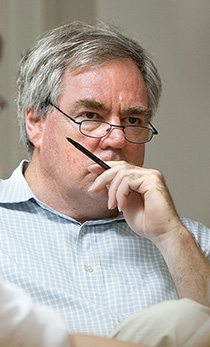
Kent Hubbell. See larger image
Dean of Students Kent Hubbell '67, B.Arch. '69, and Vice President for Student and Academic Services Susan Murphy '73, Ph.D. '94, have seen incredible changes at Cornell in the decades since they were students. But despite growth in distance learning, off-campus housing construction and a new tech campus in New York City, they believe that a residential campus will remain vital to the undergraduate experience 50 years from now.
"I would suspect there will be much more flexibility of students coming and going," Murphy says. "They may be able to start some of their Cornell experience away [from campus]; they may, when they go away, be able to stay more connected academically – so I think it will be a more fluid educational experience."
Hubbell, who was a freshman in 1963, is confident that in another 50 years, "Cornell will still be Cornell. If we looked around there will be a lot that will be familiar. And if you talked to the students of that time you will hear many of the same things that you hear now."
Both say they favor having all freshmen and sophomores live on campus.
"My personal dream is that we have a more residential campus – that we house more of our students, and, in doing so, we support [them] more effectively," Hubbell says. "The first-year living experience on North Campus has been an unequivocal success. Students think fondly of that first year on campus." Requiring students to live on campus can "level the experience," he adds, with fewer apparent disparities of race, class and income.

Susan Murphy. See larger image
Both also support the expansion of mixed-gender Greek chapters in the system, and Hubbell says that "more house scholars and house mentors would enrich the experience for fraternities and sororities."
"I am a supporter of small residential communities," such as co-ops and program houses, Hubbell says. "They break down a great big anonymous campus into bite-sized pieces for our students."
Changing demographics also will affect the student experience.
"We will see a population shift, an increase in the international community, and we'll be more ethnically diverse," Murphy says. "In this year's first-year class, only 40 percent are Caucasian. Fifty years ago, the female population was maybe a quarter of students – now it is 51 percent."
And while Murphy notes that in 2065 many graduate students may "only know Cornell through distance-based education," there should be no worry that Cornell is going anywhere.
"The heart of campus will remain in Ithaca," she says.
– Daniel Aloi
Finally, your own spacecraft
Mason Peck is an associate professor of mechanical and aerospace engineering who served as NASA's chief technologist from January 2012 to December 2013.
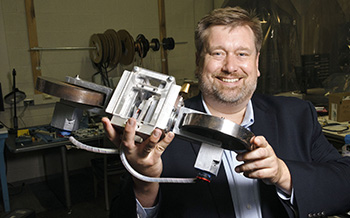
Mason Peck See larger image
By the mid-21st century, innovations in flight beyond the Earth will form the core of aerospace research. Entrepreneurial space companies are building rockets, Earth-observation satellites, satellite-servicing platforms and asteroid-mining robots. There are private plans to send people into orbit, to the moon, and to Mars in the coming decade, most of which will happen with the support of venture capital.
At the same time, NASA has sponsored development of new technologies to push the boundaries of science and exploration. It's now commonplace for students at universities (and even some in high schools) to build small satellites. Members of the so-called Maker community are passionately taking ownership of technology development, and we find that using 3-D printers and other additive-manufacturing technologies can accelerate putting hardware into orbit.
In the coming decades aeronautics will embrace consumer electronics paradigms to reject the old principles that drive cost and schedule for space systems. Fifty years from now, academic research will personalize exploration with small spacecraft, vehicles built in orbit and on other planetary bodies. Aerospace research will change the face of our planet and beyond, enabling robotic and human spaceflight, all thanks to innovations underway right now.
That research will focus on the use of in-space resources – such as regolith [loose rocky material] and water from the moon and asteroids – to build exploration infrastructure across the solar system. Aerospace will remain a fundamentally multidisciplinary field, and its impact on our daily lives will continue to grow, as more of us travel to Earth orbit and beyond.

From left to right: Rohit Verma and Thomas R. Bruce
Hospitality sprawl
The hospitality industry is dynamic, evolving and intricately interwoven with numerous other industries. But what makes it a rich space for careers and academic study also makes its long-term trajectory tricky to extrapolate.
Rohit Verma, the Singapore Tourism Board Distinguished Professor in Asian Hospitality Management, professor of services operations management at the School of Hotel Administration and co-director of the biennial Cornell Hospitality Research Summit, offers five projections based on his hospitality research and interaction with industry:
"We won't have a regional hospitality industry; everything will be global," he says. "We are already seeing the trend. Companies from all parts of the world will have operations in all parts of the world." He foresees similar trends in space tourism, as exemplified by SpaceX and other companies making similar plans. Regional compartmentalization isn't adaptive, he says, when the new frontier is, perhaps, the moon.
Verma predicts, "We won't have an industry that we call the hospitality industry" in the traditional sense. "It will be part of health care, part of retail, part of manufactured goods and so on."
"Traditionally, [hospitality] has been about humans delivering service to other humans," Verma says. "But we're seeing evolution of more technology-based service, and service will increasingly have a huge technology component … Months in advance of people coming to a hotel, they will use technology to do things like take a virtual tour, and digital media factors ever more heavily into the post-service experience."
"Right now, we are seeing new stages of the 'sharing economy,' like Airbnb," Verma explains. "In 25 to 50 years, this sharing economy will become a big, dominant sector of the industry. People will be looking for far more personalized options."
Cornell and other high-ranking institutions will adapt with industry, he predicts. "I think there are already indications that the generalist degrees and education programs will be less in demand, whereas more specialized knowledge and skills will be highly in demand, because everything will become more specialized."
– Mike Webb
Smart law
Thomas R. Bruce is the director of Cornell Law School's Legal Information Institute (LII), which since 1992 has provided online, open access to the laws that govern us. About 29 million unique visitors a year from 240 countries and territories use the LII website.
The LII's mission is to help people find and understand the law. The technical challenges of finding those laws – so prominent when we started 20 years ago – are melting away, unevenly. So unevenly, in fact, that I bet that 50 years from now we will still be helping people somewhere in the world obtain the level of access to legal information that people in many Western democracies have now.
But simply making law available is not enough. Understanding is a stiffer challenge. Right now, we communicate the text of laws but we convey little about procedure. It's as though we publish a ranked list of poker hands, but say nothing about the rules of dealing or betting. Conveying the full panorama of the legal process to those who are or might be involved with it is an obvious next step.
In 50 years I hope that we will be working on – maybe we will have solved – the vast problems involved in presenting the law, via whatever technologies we then have, in a way that embraces the full context of economics, politics and social trends. By then we should be building systems that can respond to questions like, "What unforeseen legal risks are embedded in my business plan?" or "Why have no bankers gone to jail for the events of 2008?" with answers that comprehend not only the scaffolding of primary law involved but integrate those materials with the legal, economic, social and political perspectives that are tied to them. We'll be presenting the user with an integrated, explanatory view.
We have spent more than 20 years making the law available, with computers and the Internet as our best tools. Right now we can disseminate the law that's in the books. Disseminating law in action, in full context, seems to me a five-decade challenge.

From left to right: Ling Qi and Maureen O'Hara
The cure(s) to obesity
Ling Qi, associate professor of nutritional sciences, is doing groundbreaking work to understand how fat cells develop and act in the body.
In 1990, about 10 percent of the adult U.S. population was obese. Today, roughly two-thirds of U.S. adults are overweight or obese; even more alarming is the rising prevalence of obesity in children and the elderly. Obesity is in large part responsible for a dramatic increase in type-2 diabetes and other chronic diseases. Bringing these problems under control will take a concerted, global effort across many disciplines.
A few decades down the road, Qi says:
Humans will have a much better understanding of disease-causing genetic mutations for many disorders. The latter will remain a focus of basic research scientists;
Gastric bypass will have become the best approach to curing obesity-associated complications;
Scientists will have developed pills that effectively keep obese people "metabolically healthy"; and
Type-2 diabetes will no longer be a prevalent disease in aging populations.
Qi's laboratory is working to determine the effects of protein folding, misfolding and aggregation in various cell types involved in metabolism, as well as pathogenesis of obesity and type-2 diabetes. Working with biochemists, cell biologists, chemists, nutritionists and food scientists, Qi hopes the coming years will establish research paradigms in these areas, as well as lead to novel therapeutic strategies for targeting protein folding and secretion.
– Anne Ju
Transparent markets
Markets have become increasingly fragmented, says Maureen O'Hara, the Robert W. Purcell Professor of Management and professor of finance at the Samuel Curtis Johnson Graduate School of Management. U.S. stocks once traded on either NYSE or Nasdaq, but trades now take place in virtual and physical exchanges worldwide.
O'Hara is an expert on market microstructure, and her recent research has focused on high-frequency trading.
"In the old days on the stock exchange floor, there were hundreds of people milling around. Now there are far fewer, and most of them are reporters," she says. "We have 13 physical equity exchanges, and more than 50 places altogether where you can trade equities."
In the decades ahead, there will be more virtual exchanges and fewer people working in and with them, O'Hara says.
High-frequency trading, where traders use complex algorithms to analyze markets and execute orders at very fast speeds, will lose its distinctiveness because technology gives everyone in the market the same speed and latency. Yet the pressure to execute more quickly than competitors will remain.
"Even 50 years from now, when we are trading at the speed of light, someone will be faster," O'Hara says.
Markets have innovated with the power of technology, yet regulatory structures lag behind. This is leading to a period where changes in markets will slow while regulatory structures increase significantly. This process is beginning to affect bond markets; the result is a bond market that's not transparent in which it's difficult for traders to know if they are getting a good price.
"Regulators have indicated that this is the area that will be changing dramatically," O'Hara says. "That's all for the best – there's nothing to be gained from not moving to a more transparent bond-trading system."
– Shannon Dortch
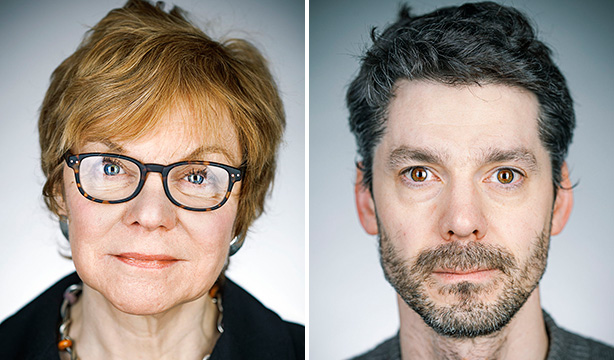
From left to right: Susan Christopherson and Roger Moseley
Giant cities
Susan Christopherson, professor and chair of city and regional planning (CRP), points out that there will be more cities, bigger cities, and that a larger percentage of us will live in cities. "Of the projected 41 megacities over 10 million, 13 will be over 20 million in size. Many of these megacities will grow in Asia and Africa and will be places of profound poverty, struggling to provide health services and education as well as water, sanitation and transportation infrastructure. They will also be places of creativity and human resilience."

Thomas J. Campanella See larger image
CRP associate professor Thomas J. Campanella says that "prevailing trends bode good and ill for cities over the next half-century." Older city centers in the United States will continue to have new value, "as educated elites at both ends of the life spectrum flock there – the young seeking local grit and 'authenticity' to counter the anomie of globalized mass culture; the old seeking culturally rich communities in which to retire and 'age in place.'"
A walkable city "is a scarce commodity in our sprawled-out nation," Campanella says. "In time, the trend back to the city will pay huge environmental dividends by reducing automobile use and encouraging investment in public transit. Its pace will only accelerate as millennials enter the workforce."
On the downside, he notes, "rising demand will force property values through the roof in places like Brooklyn and San Francisco, and eventually extend to cities and neighborhoods far off the radar of urban chic. Gentrification of the core will create a new geography of race and class in America. As the poor are forced outward to declining first-ring suburbs, the prevailing pattern of suburban affluence and inner-city blight will be turned on its head. Ferguson, Missouri, will be the new South Bronx."
Christopherson believes urban planners "will create the links between our urban past and our urban future" and "will play a 'big picture' role in responding to the challenges … searching for solutions that tackle underlying dynamics – not just symptoms like urban congestion."
Planners seeking long-term solutions will promote new approaches to "create dense, energy-efficient cities where the automobile plays a minor role and engage communities and real estate developers in an urban design process in which good design adds value," Christopherson says.
Urban planning "will emerge as a prominent educational model for combining theoretical knowledge about the urban condition with civic engagement and action," she says.
– Daniel Aloi
Far out music
Roger Moseley is an assistant professor of music as well as a music historian and ludomusicologist (a researcher devoted to musicological approaches to videogame music).
When looking to the musical future, the extrapolation of current trends – such as the commodification of music as binary information – can only take us so far.
In recent years, the resurgence of independent musicians and live performances have already countered the digital doom and gloom that engulfed the music industry at the turn of the millennium. But I believe that two current trends look set to accelerate.
First, music will continue to develop as a spatial art form as well as a temporal one. This tendency is evident in sound art installations and advanced electro-acoustic composition – areas in which Cornell's Department of Music excels – but is also driven by the simple fact that music is no longer tied to a single place of origin: it travels with its listeners, whether they are on the bus, at work, in bed or at the beach.
Via developments in virtualization technologies, musical signals will respond to these changing conditions and playback will be adjusted accordingly, perhaps via implants or bone conduction rather than headphones or speakers. As for the content of that music, it's likely that your smartphone apps already presume to know your tastes better than you do. Soon, such apps will be able to alter the key, tempo and instrumentation of your music in real time to suit (or improve) your state of mind.
If this sounds too utopian or apocalyptic, my other prediction is more down to earth: the musical past will have a future, too. Cornell has a proud history of pioneering research into the historically informed performance of music. Currently, the Department of Music is collaborating with the Westfield Center for Historical Keyboard Studies to establish a center for Cornell's unique collection of harpsichords, (forte)pianos and organs, making them available to local and international communities of musicians and scholars.
By safeguarding the future of these wonderful instruments, which constitute an invaluable resource for preserving and reanimating musical soundscapes ranging from Mozart's "Vienna" to Bob Moog's "Trumansburg," we hope to ensure that they will be still be heard loud and clear in 50 years' time.
It's a bird, it's a plane, it's … a sociologist
Ben Cornwell is an assistant professor of sociology and researches socially networked social processes for individuals and organizations.
One thing I foresee in the next 50 years is that sociology will be regarded increasingly as a discipline of scholars who collaborate with people in other fields. This is already happening in medicine and in information and computer sciences. For example, sociologists who are trained in the techniques of network analysis have begun to team up with medical doctors to understand how diseases and other health problems (like obesity) spread through society. Sociologists' knowledge of relational processes has also helped computer scientists design more effective social networking sites.
The connection between sociology and information science is something that Cornell has cultivated particularly well. Recent studies by sociology faculty members include an analysis of the role of Twitter in Arab Spring movement mobilization, and the use of smartphones to track the real-time movement of New York City residents through their neighborhoods and other spaces.
And I can only see social inequality becoming a bigger issue over the next 50 years., Sociologists will be quick to harness computational and other emerging tools to improve our ability to analyze and solve problems associated with social inequality.
A labor renaissance
As a professor of labor history, Ileen DeVault has seen the future – and it's not your father's union.
"Less than 8 percent of the American private sector workforce belongs to a union. That's really miniscule," she says, compared to the heyday of organized labor when the School of Industrial and Labor Relations started 70 years ago.
"We've gone from huge, mass-production factories that were the base of the union movement to minimum-wage jobs at McDonald's and Wal-Mart. Unions have a hard time organizing today's workers. For a long time they didn't even try – and when they tried, it was too late.
"What we've seen over the past 10 years is a recovery from a sort of crisis of confidence in the labor movement, leading to new strategies for organizing workers. We see that in the push for increasing minimum wage, the call for $15 an hour."
Meanwhile, a new kind of support structure isn't waiting for increased minimum wages, DeVault observes. "Worker centers are organizing today's labor force – not around workplaces, but often around ethnic identity. They are saying, 'We'll help you find and keep a job. We'll train you for different kinds of jobs, we'll help you find childcare, and work with you on immigration issues.'"
Typical of the worker center movement, DeVault says, are organizations like the New York City-based Domestic Workers United (DWU), representing Caribbean, Latina and African nannies and housekeepers. After ILR extension associates helped DWU set up training-and-certification programs for nannies, other worker centers (serving Nepali and Filipina immigrants) asked ILR extension to do the same for eldercare workers.
"Worker centers are evidence that people want and need a collective voice in their working and living conditions – and that is not going to go away," DeVault says. "In 50 years, people will still want a voice in what happens to them in their daily, hour-by-hour lives."
– Roger Segelken
Resurrecting the right to be left alone
Ken Birman is the N. Rama Rao Professor of Computer Science in the Faculty of Computing and Information Science. His research focus is on large-scale computing systems that require guarantees such as security, reliability or fault-tolerance.
When I look 50 years into the future, I can't help reflecting on the degree to which computing technologies have reshaped the social experience. This brings many very positive things: my wife and I are able to stay in touch with our children and relatives in ways that would have been unimaginable when I was 9 years old, and I can't remember how we managed without Web search!
Without question, 50 more years of technology progress will bring remarkable capabilities. On the other hand, the erosion of privacy and the emergence of a kind of ubiquitous surveillance structure is very worrying.
Rapid change can be disorienting. The mechanical revolution of the 1800s must have felt that way, and this has certainly been true for the Web. I suspect that our tolerance of this erosion of freedoms is in part a consequence of the scope and speed of the change we are experiencing. But eventually, any period of ultra-rapid change ebbs and a new status quo emerges.
Sometime in the coming years, we'll wake up to discover ourselves completely exposed, constantly monitored: every detail of our lives captured and archived, and all readily accessible to anyone who cares to search for it. Today's highly targeted advertising is already intrusive. In years to come, we'll see more and more use of such information to directly manipulate public opinion, and very likely also to target those who disagree with powerful individuals. We [will] confront a profound threat to personal liberty.
But I'm an optimist and 50 years is a long time. I believe that 50 years from now, there will have been enough pushback to trigger a sweeping movement to resurrect 'the right to be left alone.' A new generation of laws, coupled with a major effort to create technologies capable of protecting our privacy, could reverse the current trends.
Animals (and problems) live in the real world
The days of "one person working in a laboratory or in the field by themselves, on one question, are already over," says Alex Travis, associate professor of reproductive biology and associate dean of international programs at the College of Veterinary Medicine.
Travis predicts that in the future, researchers will be organized around interdisciplinary problems, rather than by discipline or department. He also sees many more interactions with the private sector in academia's future. "The funding mechanisms are broken," he says, noting that researchers wait many months to apply for and receive funds. By the time funding comes, "the problem has changed–the world moves too quickly for that," he says. "Ties with the real world where you work with partners to identify problems together and co-create solutions, that's the future."
The College for Veterinary Medicine's Center for Animal and Public Health (Travis is its director) is trying to make those connections stronger by forging closer connections between crop and soil scientists, veterinarians, economists and human nutritionists, for example.
It's a systems-based approach that will optimize the best farming strategies for the future of the planet and reduce diseases in human and animal populations while preserving the goods and services that nature provides, he says.
"We're going to have to get out in front of things if we really want to preserve any semblance of what we would consider today to be the normal world."
– Joe Wilensky
Digital preservation in 50 years
Danielle Mericle directs the Digital Media Group at Cornell University Library.
We live in a very tenuous time with regards to media and hardware obsolescence, and we risk losing a large amount of data in the form of audiovisual material and born-digital content. If we don't act soon to migrate this content to a more stable platform, it will be irretrievably gone from the human record.
That's where the library comes in. It's impossible to predict specific technology, but we know that the exponential growth rate of technology and information will pose both major challenges and opportunities for our digital preservationists. We know that our field undoubtedly will make significant advancements and storage costs will continue to drop.
But this is a double-edged sword: Fast-paced technology requires constant upkeep and migration work, and data is becoming increasingly complex and layered. Already, we have to think about preserving "ecosystems" in which information exists, and not just the bits or bytes alone. This will only become more challenging in the future, and to be successful in this constantly shifting terrain, we need to be fluid and adaptable.
We also need to be strategic in our selection of what to preserve. With the explosion of information, it's impossible to preserve everything, and inevitably there will be some loss. By partnering with peer institutions and identifying areas of subject expertise, we can share the burden and strategically mitigate that loss.
Cornell University Library has a team of hardworking staff assessing our vulnerabilities in terms of audiovisual content, new media art and overarching digital preservation. Our goal is to stay ahead of the curve.
Design's new shape: Interdisciplinary
Mardelle Shepley, professor of design and environmental analysis, is an architect and researcher who studies health facility design and environmental sustainability.
Three important factors will drive the future of health care design: interdisciplinary research, enhanced globalization and advances in technology:
Design research has become an interdisciplinary movement. For example, neuroscientists have begun to explore the cerebral processes that occur as we experience space. We will use these findings and other interdisciplinary insights to build healing environments.
Awareness of health care design principles is becoming more international with rapid Internet communication. However, resources in many parts of the world are limited, and designers must come together to address global needs.
We can expect remarkable advances in medical technology. Health care designers will have to be agile and ready to adapt to new advancements.
Priority one for sustainable enterprise: Climate change
Mitigating climate change presents the greatest business opportunity of the next 50 years; to meet it, companies must innovate constantly and rapidly, says Mark Milstein, clinical professor of management and executive director of the Center for Sustainable Global Enterprise at the Samuel Curtis Johnson Graduate School of Management.
In recent decades, many businesses have advanced from models of corporate responsibility to something bolder – creating solutions to pressing global problems, and making money in the process. The next 50 years offer businesses an opportunity to make money by addressing climate change. Without innovative solutions, Milstein says, firms will feel the pain just like everyone else.
"Fifty years may seem a long way off, but when you see the changes in the climate that have occurred in the past 50 years, and where it's likely to go in the next 50, it becomes very problematic," Milstein says. "You can't simply turn climate change off – heat takes time to build and decades, if not centuries, to dissipate."
Businesses can expect greater disruptions in their supply chains. Anything from extraction to cultivation is at risk. Extreme weather events can impair shipping, manufacturing and distribution. Even the availability of fresh water is expected to decline, exacerbated by salt water migration inland from rising oceans.
Some companies are trying to create business models, products, services and technologies aimed at "decarbonizing" the economy. Yet such processes are difficult, he says: "Research has shown that it can take a decade for a company to develop, test and commercialize new technology."
What's more, businesses don't operate in a vacuum. Governments set rules that effect markets for technologies that might reduce carbon emissions. In Germany, for example, public and private money has helped the renewable energy market to develop, but stranded assets in traditional utilities.
"It is going to be a combination of business, government and civil society that allow for an effective transition to an economy with low CO2 emissions," Milstein says.
This will be a challenge in the United States, he says, where vocal detractors maintain that climate change doesn't exist, and where enormous corporations have much to lose. Yet these barriers must be overcome.
"Addressing climate change is the pivotal issue in the lifetime of students coming through Cornell today," Milstein says. "If we can't get a handle on this, the lives of their children and grandchildren will be significantly impaired."
– Shannon Dortch
Learning never stops
In the summer of 1876, Cornell launched its continuing education program by offering geology, zoology and entomology to elementary- and secondary-school teachers, thus becoming one of the first universities to offer courses to people other than traditional full-time undergraduates.
Today, the School of Continuing Education (SCE) offers college-level summer school for high school students from around the world, intensive professional residencies for businesspeople and hospitality executives, extramural study for Cornell employees and residents, for-credit courses for students enrolled in other universities, and popular Cornell's Adult University (CAU) summer courses – both on campus and in faraway places like Chile, Israel and Morocco.
When asked to predict the distant future, SCE dean Glenn Altschuler, Ph.D. '76, says the school will take advantage of technological advances and a more globally-connected world to continue the same mission it has today: to serve students where(ever) they are.
"As the technology permits, more online learning will occur," says Altschuler, who points out that in the past three years, a significant number of online courses have been added to the list of SCE's offerings.
"One thing I hope never changes is the on-campus summer programs," says Katie Bartels '06. She enjoyed living in her old freshman dorm in summer 2014 while taking a 3-D printing class, professional development for her jewelry business, and a wine course through CAU. Cornell alumni in 2065, she says, will enjoy feeling "like undergraduates again" as much as alumni do now.
Ross Brann, professor of Near Eastern studies, is a veteran teacher in the CAU study trips program. Global politics change with time, he says, opening some study trips while closing others; he taught a course in Egypt in 2010, shortly before the January 25 revolution started there.
"Hopefully these will be places we'll be visiting again," he says, envisioning a future in which a healthy world economy and peaceful, open borders will allow SCE to offer study trips to any place in the world.
– Kate Klein
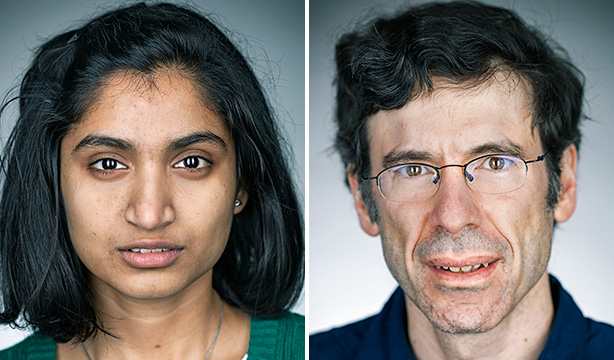
From left to right: Sushmitha Krishnamoorthy and Jon Kleinberg
Resist roommate-matching algorithms
Sushmitha Krishnamoorthy '17 is from New Delhi, India. She is a computer science major in the College of Arts and Sciences.
What makes Cornell amazing is that it draws a transient mix of diverse people and ideas. Every day, I meet someone who is radically different from me, simply by chance. And I learn things I might otherwise never have known. I watched the South African stand-up comedy show "That's Racist" with a friend from Zimbabwe and realized how similar the challenges faced by young democracies – India and South Africa – are. From the rants of my roommate, an exchange student from Switzerland, I learned about the cultural differences between Europe and America. Ever since, South Africa and Switzerland have been on my travel list.
But in 50 years, personal data and machine learning might make that kind of serendipity impossible. Freshmen would love their like-minded roommates because the algorithm would match them perfectly based on personal information. An app would accurately predict which parties they are most likely to enjoy, based on other attendees. It might even tell them who they should be friends with.
While some of these ideas sound exciting, I'm afraid it would completely reshape the Cornell experience as I know it. Cornell's bicentennial students wouldn't interact with people unlike themselves or take a class in something they know little about. Although I'm a computer science major, I really enjoyed Introduction to Acting and a seminar in urban planning.
However, I know there is one thing that will not change. As climate change causes extreme weather conditions, the winters here are unlikely to mellow in the future. In 2065, perhaps my grandchildren will be at Cornell, telling me that the university doesn't cancel classes even during terrible snowstorms. I shall nod in agreement, knowing that Cornellians of all ages can bond over memories of harsh Ithaca winters, if nothing else.
Privacy and peace
Jon Kleinberg '93 is interim dean of the Faculty of Computing and Information Science, a Tisch University Professor, professor of computer science, and professor and chair of information science.
In my freshman year at Cornell, I would sometimes sit working in the stacks of Uris Library, a little awed by the surroundings, and I would think, "This is college." And later in the day, passing through a crowd of fellow students in front of Willard Straight Hall, the thought would come to me again, this time mingling with the din of the plaza – "This is college." And both those opposite thoughts still feel true today.
It would be fair to say that higher education created the World Wide Web in its own image, and it imparted to the Web those two powerful guiding structures – the library and the crowd. The library has been there since the Web's beginning, with the movement of human knowledge so rapidly online, and with the rise of search engines as reference librarians to the world. And the crowd – the teeming online mass of people who react in real time – is there as well, to tweet and tag and post viral content before an event has even concluded.
This is the digital world, and it has given us a set of big questions to keep us busy for the next 50 years. In the universal library of human knowledge and understanding, how do we decide what is featured and who gets to provide the answers to your questions? When we bring crowds together online, can we help them understand each other better as fellow human beings, reducing discord and polarization, rather than increasing it? And how do we reason about a world in which all these decisions are increasingly arbitrated by algorithms that we might no longer fully understand or control?
The technologies we build are influencing the architecture of everyday life, and addressing that transformation will require that we as computer scientists and information scientists engage deeply across the academy and with the world in all its complexity.